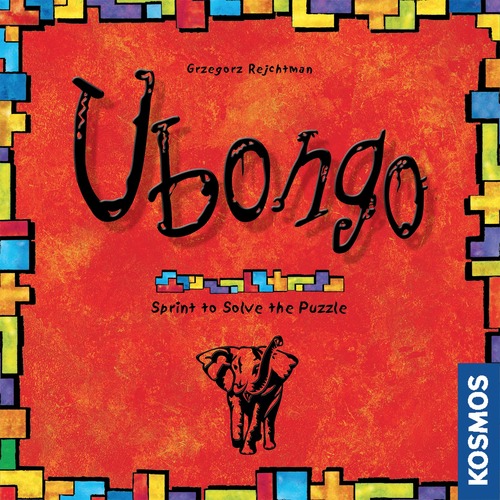In the mood for a fast-paced abstract puzzle game? Then “Ubongo” may be what you’re looking for. In this game, players will be racing to complete their individual puzzles in order to earn gems. Having the most valuable gem collection will win you the game, so get those thinking caps on and don’t dawdle! Before we go any further, I’d like to quickly thank Sarah from Southard Inc. (a representative for Thames and Kosmos) for providing me with a press copy for review purposes.
Editor’s Note: There are two recent editions of this game with slightly different scoring mechanics, so pay attention to the one you’re looking to buy. The 2015 English Edition does not have a pawn & gem board (gems are instead randomly drawn from a bag and can be collected on the round tracker), while the German 10th Anniversary Edition does. I included Amazon links to both versions at the end of this article. For the record, I received a press copy of the 2015 English edition.
Components
The game includes 36 puzzle boards, 1 die, 1 hourglass, 1 cloth bag, 1 game round track, and 58 gems (19 sapphire, 19 amber, 10 ruby, 10 emeralds). The puzzle boards are double-sided, one side requiring three puzzle pieces to solve while the other requires four. Each side lists six rows of 3/4 puzzle pieces, each of which is accompanied by a matching symbol on the die.
Setup & Gameplay
Firstly, players will decide which side of the puzzle boards they’ll all be using (three piece puzzles for an easy game and four for a more difficult one). They’ll then stack their side they’re using face-down. Each player then gets twelve different tiles, one of each color. The game round track, the die, the hourglass, and the bag containing the gems are placed onto the center of the table. Nine sapphire and nine amber gems are placed on the corresponding holes of said track.
The game is played over nine rounds. At the beginning of each round, each player takes a puzzle board and flips it to the side they’re using. The youngest player rolls the die to determine which pieces are used for the puzzle and flips the hourglass. As soon as a player fits all their tiles exactly (without overlapping or going off the grid), they’ll shout “Ubongo!”. This continues until the time runs out. If no one is able to complete their task, then they’ll flip the hourglass again for a one-time second chance.
The fastest player takes one blue sapphire from the round track and takes one randomly from the bag. The second fastest takes an amber from the round track and takes one randomly from the bag. The third and fourth fastest take one randomly from the bag. Those who did not complete their puzzle do not get to draw from the bag. This continues until all nine rounds have been played.
After nine rounds, scores are tallied. Ruby gems are worth four points, sapphire gems are worth three points, emerald gems are worth two points, and amber gems are worth one point. Whoever has the most points, wins the game!
Editor’s Note: The above doesn’t cover all of the rules found in the manual, but should give you an idea as to how the game is played.
The Review
If you ever played “Tetris”, then you know how satisfying it can be to slide that line piece into a column and clear four lines. I myself grew up with the Game Boy version and always longed to hear that coveted 8-bit sound of making a Tetris. Ubongo is similar in that regard in that you’ll give yourself a mental high-five every time you complete a board, especially on the four piece side. The game gets a thumbs-up for being educational and promoting problem solving through spatial awareness.
The scoring system is simply much too random for my tastes. Since each player who succeeded in any given round gets to draw from the bag, it’s possible for the faster player to end up with amber while others get ruby or sapphire. Sure, the fastest player does get a sapphire via the round tracker, but they can still get screwed via the random draw. I find it ironic that while the puzzles are abstract, your chance of winning is somewhat determined via the luck of the draw.
While I haven’t played the German version, I did read its manual and found that I liked its scoring system better…that is, the player can move a pawn along the gem board and actually choose which gems to take. The slower players can’t move their pawn as far, limiting their choice of gem columns. I may have to MacGyver a gem board of my own and adapt the scoring system from the German version. Why the English version doesn’t include the gem board is beyond me and in my opinion, the game suffers for it.
As it stands, the game succeeds at what it does despite my problem with the scoring system. I do appreciate the addition of a four piece side to the puzzle boards, giving parents a way to handicap themselves when playing with smaller children. The components are flashy, colorful, and top notch. The cloth bag is way too big, but I’ll get over that. This game is a definite recommend to casual gamer families who aren’t concerned with losing an abstract game due to chance…I know, it sounds weird using both the words “abstract” and “chance” in the same sentence. Regardless, its high production values and the ease of which play flows gives it the push it needs to warrant your attention.
Final Verdict: 7/10
—


